 Triumph Street Triple S - Owner's Manual > Cleaning and Storage, Specifications
Triumph Street Triple S - Owner's Manual > Cleaning and Storage, Specifications
Cleaning and Storage
Cleaning
Frequent, regular cleaning is an essential part of the maintenance of your motorcycle. If regularly cleaned, the appearance will be preserved for many years.
Cleaning with cold water containing an automotive cleaner is essential at all times but particularly so after exposure to sea breezes, sea water, dusty or muddy roads and in winter when roads are treated for ice and snow.
Do not use household detergent, as the use of such products will lead to premature corrosion.
Although, under the terms of your motorcycle warranty, cover is provided against the corrosion of certain items, the owner is expected to observe this reasonable advice which will safeguard against corrosion and enhance the appearance of the motorcycle.
Preparation for Washing
Before washing, precautions must be taken to keep water off the following places.
Rear opening of the exhausts: Cover with a plastic bag secured with rubber bands.
Clutch and brake levers, switch housings on the handlebar: Cover with plastic bags.
Ignition switch and steering lock: Cover the keyhole with tape.
Remove any items of jewelry such as rings, watches, zips or belt buckles, which may scratch or otherwise damage painted or polished surfaces.
Use separate cleaning sponges or cleaning cloths for washing painted/ polished surfaces and chassis areas.
Chassis areas (such as wheels and under fenders) will be exposed to more abrasive road grime and dust, which may then scratch painted or polished surfaces, if the same sponge or cleaning cloths are used.
Where to be Careful
Caution: Do not use high pressure spray washers or steam cleaners.
Use of high pressure spray washers and steam cleaners may damage seals, and cause water and steam to be forced into bearings and other components causing premature wear from corrosion and loss of lubrication.
Caution: Do not spray any water at all near the air intake duct.
The air intake duct is normally located under the rider's seat, under the fuel tank or near the steering head.
Any water sprayed in this area could enter the airbox and engine, causing damage to both items.
Do not get water near the following places:
- Air intake duct
- Any visible electrical components
- Brake cylinders and brake calipers
- Handlebar switch housings
- Steering head bearings
- Instruments
- Oil filler cap
- Rear bevel box breather (if equipped)
- Rear of headlights
- Seats
- Suspension seals and bearings
- Under the fuel tank
- Wheel bearings.
Note: Use of soaps that are highly alkaline will leave a residue on painted surfaces, and may also cause water spotting.
Always use a low alkaline soap to aid the cleaning process.
Washing
To wash the motorcycle, do the following:
- Make sure that the motorcycle engine is cold.
- Prepare a mixture of clean, cold water and mild automotive cleaner.
Do not use a highly alkaline soap as commonly found at commercial car washes because it leaves a residue.
- Wash the motorcycle with a sponge or soft cloth. Do not use abrasive scouring pads or steel wool. They will damage the finish.
- Rinse the motorcycle thoroughly with clean, cold water.
After Washing
Warning: Never wax or lubricate the brake discs.
Always clean the brake disc with a proprietary brand of oil-free brake disc cleaner.
Waxed or lubricated brake discs may cause loss of braking power and an accident.
After washing the motorcycle, do the following:
1. Remove the plastic bags and tape, and clear the air intakes.
2. Lubricate the pivots, bolts and nuts.
3. Test the brakes before motorcycle operation.
4. Use a dry cloth or chamois leather to absorb water residue. Do not allow water to stand on the motorcycle as this will lead to corrosion.
5. Start the engine and run it for 5 minutes. Make sure that there is adequate ventilation for the exhaust fumes.
Care of Gloss Paintwork
Gloss paintwork should be washed and dried as described previously, then protected using a high quality automotive polish. Always follow the manufacturer's instructions and repeat regularly to maintain your motorcycle's appearance.
Care of Matt Paintwork
Matt paintwork requires no greater care than that already recommended for high gloss paintwork.
- Do not use any polish or wax on matt paintwork.
- Do not try and polish out scratches.
Aluminum Items - not Lacquered or Painted
Items such as brake and clutch levers, wheels, engine covers, engine cooling fins, upper and lower yokes and throttle bodies on some models must be correctly cleaned to preserve their appearance. Please contact your dealer if you are unsure which components on your motorcycle are aluminum parts not protected by paint or lacquer, and for guidance on how to clean those items.
Use a proprietary brand of aluminum cleaner which does not contain abrasive or caustic elements.
Clean aluminum items regularly, in particular after use in inclement weather, where the components must be hand washed and dried each time the machine is used.
Warranty claims due to inadequate maintenance will not be allowed.
Cleaning of Chrome and Stainless Steel Items
All chrome and stainless steel parts of your motorcycle must be cleaned regularly to avoid a deterioration of its appearance.
Washing
Wash as previously described.
Drying
Dry the chrome and stainless steel parts as far as possible with a soft cloth or chamois leather.
Protecting
Caution: The use of products containing silicone will cause discoloration of the chrome and stainless steel parts and must not be used.
The use of abrasive cleaning products will damage the finish and must not be used.
When the chrome and stainless steel is dry, apply a suitable proprietary chrome cleaner on to the surface, following the manufacturer's instructions.
It is recommended that regular protection be applied to the motorcycle as this will both protect and enhance its appearance.
Black Chrome
Items such as headlight bowls and mirrors on some models must be correctly cleaned to preserve their appearance. Please contact your dealer if you are unsure which components on your motorcycle are black chrome parts.
Maintain the appearance of black chrome items by rubbing a small amount of light oil into the surface.
Cleaning of the Exhaust System
All parts of the exhaust system of your motorcycle must be cleaned regularly to avoid a deterioration of its appearance.
These instructions can be applied to chrome, brushed stainless steel and carbon fiber components; matt painted exhaust systems should be cleaned as above, noting the care instructions in the Matt Paintwork section previously.
Note: The exhaust system must be cool before washing to prevent water spotting.
Washing
Wash as previously described.
Make sure that no soap or water enters the exhausts.
Drying
Dry the exhaust system as far as possible with a soft cloth or chamois leather. Do not run the engine to dry the system or spotting will occur.
Protecting
Caution: The use of products containing silicone will cause discoloration of the chrome and stainless steel parts and must not be used.
The use of abrasive cleaning products will damage the finish and must not be used.
When the exhaust system is dry, apply a suitable proprietary motorcycle protection spray onto the surface, following the manufacturer's instructions.
It is recommended that regular protection be applied to the system as this will both protect and enhance the system's appearance.
Seat Care
Caution: Use of chemicals or high pressure spray washers is not recommended for cleaning the seat.
Using chemicals or high pressure spray washers may damage the seat cover.
To help maintain its appearance, clean the seat using a sponge or cleaning cloth with soap and water.
Windshield Cleaning (if equipped)

Warning: Never attempt to clean the windshield while the motorcycle is in motion as releasing the handlebars may cause loss of motorcycle control and an accident.
Operation of the motorcycle with a damaged or scratched windshield will reduce the rider's forward vision. Any such reduction in forward vision is dangerous and may lead to loss of motorcycle control and an accident.
Caution: Corrosive chemicals such as battery acid will damage the windshield. Never allow corrosive chemicals to contact the windshield.
Caution: Products such as window cleaning fluids, insect remover, rain repellent, scouring compounds, gasoline or strong solvents such as alcohol, acetone, carbon tetrachloride, etc. will damage the windshield.
Never allow these products to contact the windshield.
Clean the windshield with a solution of mild soap or detergent and clean, cold water.
After cleaning, rinse well and then dry with a soft, lint-free cloth.
If the transparency of the windshield is reduced by scratches or oxidation which cannot be removed, the windshield must be replaced.
Care of Leather Products
It is recommend that the leather products are periodically cleaned with a damp cloth and allowed to dry naturally at room temperature. This will maintain the appearance of the leather and ensure the long life of the product.
The Triumph leather product is a natural product and lack of care can result in damage and permanent wear.
Follow these simple instructions to prolong the life of the leather product:
- Do not use household cleaning products, bleach, detergents containing bleach or any kind of solvent to clean the leather product.
- Do not immerse the leather product in water.
- Avoid direct heat from fires and radiators which can dry out and distort the leather.
- Do not leave the leather product in direct sunlight for prolonged periods of time.
- Do not dry the leather product by applying direct heat to it at any time.
- If the leather product does get wet, absorb any excess water with a soft clean cloth then leave the leather product to dry naturally at room temperature.
- Avoid exposure of the leather product to high levels of salt, for example sea/salt water or road surfaces that have been treated during the winter for ice and snow.
- If exposure to salt is unavoidable, clean the leather product immediately after each exposure using a damp cloth then leave the leather product to dry naturally at room temperature.
- Gently clean any minor marks with a damp cloth then leave the leather product to dry naturally at room temperature.
- Place the leather product in a fabric bag or cardboard box to protect it when in storage. Do not use a plastic bag.
Storage
Preparation for Storage
To prepare the motorcycle for storage, do the following:
- Clean and dry the entire vehicle thoroughly.
- Fill the fuel tank with the correct grade of unleaded fuel and add a fuel stabilizer (if available), following the fuel stabilizer manufacturer's instructions.
Warning: Gasoline is extremely flammable and can be explosive under certain conditions.
Turn the ignition switch off. Do not smoke.
Make sure the area is well ventilated and free from any source of flame or sparks; this includes any appliance with a pilot light.
- Remove the spark plug from each cylinder and put several drops (0.17 fl
oz (5 cc) ) of engine oil into each cylinder. Cover the spark plug holes
with a piece of cloth or rag.
With the engine stop switch in the RUN position, push the starter button for a few seconds to coat the cylinder walls with oil. Install the spark plugs, tightening to 9 lbf ft (12 Nm).
- Change the engine oil and filter.
- Check and if necessary correct the tire pressures (see the relevant Specification section).
- Set the motorcycle on a stand so that both wheels are raised off the ground. (If this cannot be done, put boards under the front and rear wheels to keep dampness away from the tires).
- Spray rust inhibiting oil (there are numerous products on the market and
your dealer will be able to offer you local advice) on all unpainted metal
surfaces to prevent rusting.
Prevent oil from getting on rubber parts, brake discs or in the brake calipers.
- Lubricate and if necessary adjust the drive chain.
- Make sure the cooling system is filled with a 50% mixture of coolant (noting that HD4X Hybrid OAT coolant, as supplied by Triumph, is pre-mixed and requires no dilution) and distilled water solution.
- Remove the battery, and store it where it will not be exposed to direct sunlight, moisture, or freezing temperatures. During storage it should be given a slow charge (one Ampere or less) about once every two weeks.
- Store the motorcycle in a cool, dry area, away from sunlight, and with a minimum daily temperature variation.
- Put a suitable porous cover over the motorcycle to keep dust and dirt from collecting on it. Avoid using plastic or similar non-breathable, coated materials that restrict air flow and allow heat and moisture to accumulate.
Preparation after Storage
To prepare the motorcycle to be ridden after storage, do the following:
- Install the battery (if removed).
- If the motorcycle has been stored for more than four months, change the engine oil.
- Check all the points listed in the Daily Safety Checks section.
- Before starting the engine, remove the spark plugs from each cylinder.
- Put the side stand down.
- Crank the engine on the starter motor several times.
- Re-install the spark plugs, tightening to 9 lbf ft (12 Nm), and start the engine.
- Check and if necessary correct the tire pressures (see the relevant Specification section).
- Clean the entire vehicle thoroughly.
- Check the brakes for correct operation.
- Test ride the motorcycle at low speeds.
Specifications
Street Triple RS
Dimensions, Weights and Performance
A list of model specific dimensions, weights and performance figures is available from your authorized Triumph dealer, or on the Internet at www.triumph.co.uk.
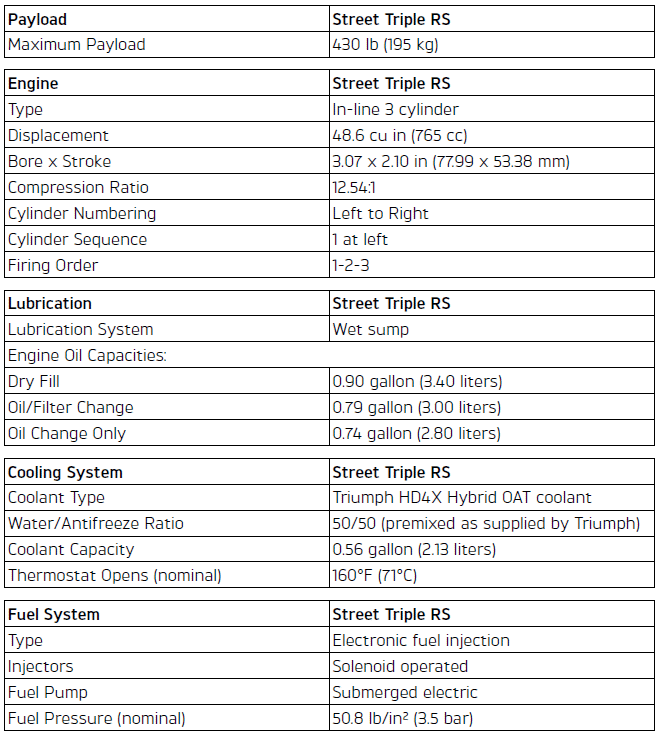
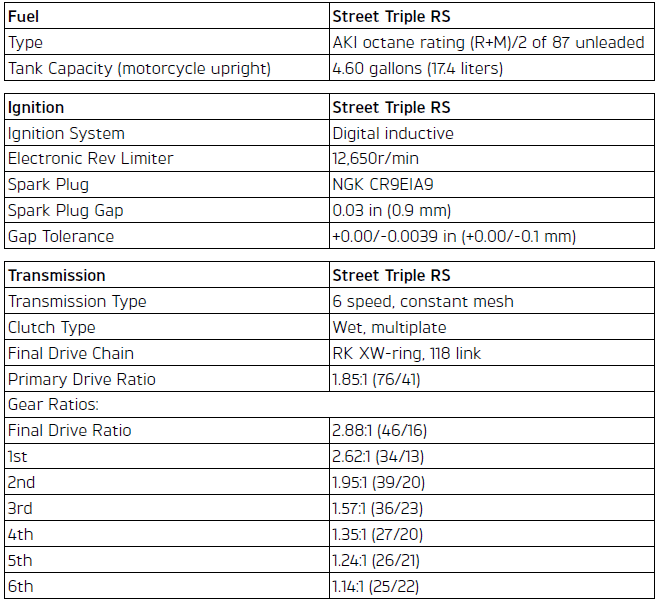
Warning: Use the recommended tires ONLY in the combinations given.
Do not mix tires from different manufacturers or mix different specification tires from the same manufacturers as this may result in loss of motorcycle control and an accident.
Approved Tires
A list of approved tires specific to these models is available from your authorized Triumph dealer, or on the Internet at www.triumph.co.uk.
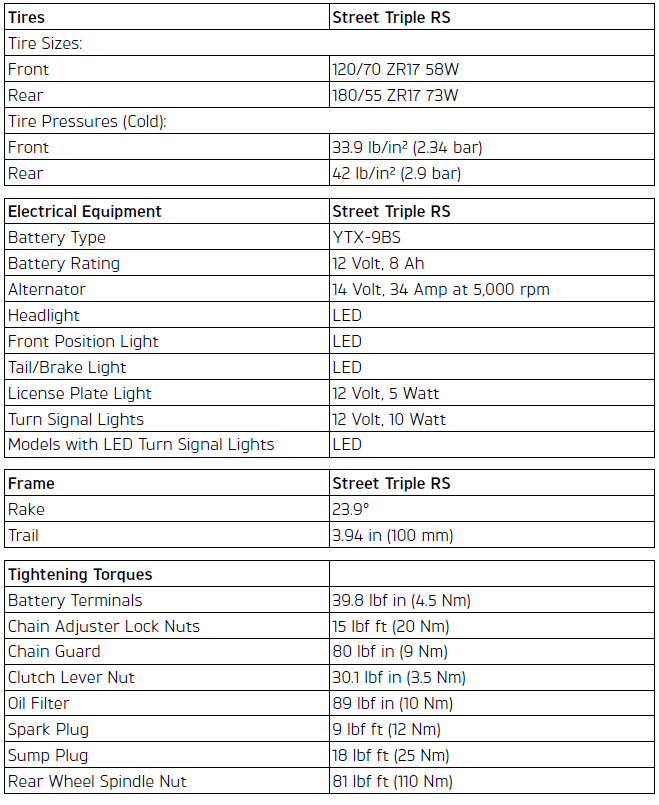

Specifications
Street Triple S (40.2 cu in (660 cc) )
Dimensions, Weights and Performance
A list of model specific dimensions, weights and performance figures is available from your authorized Triumph dealer, or on the Internet at www.triumph.co.uk.
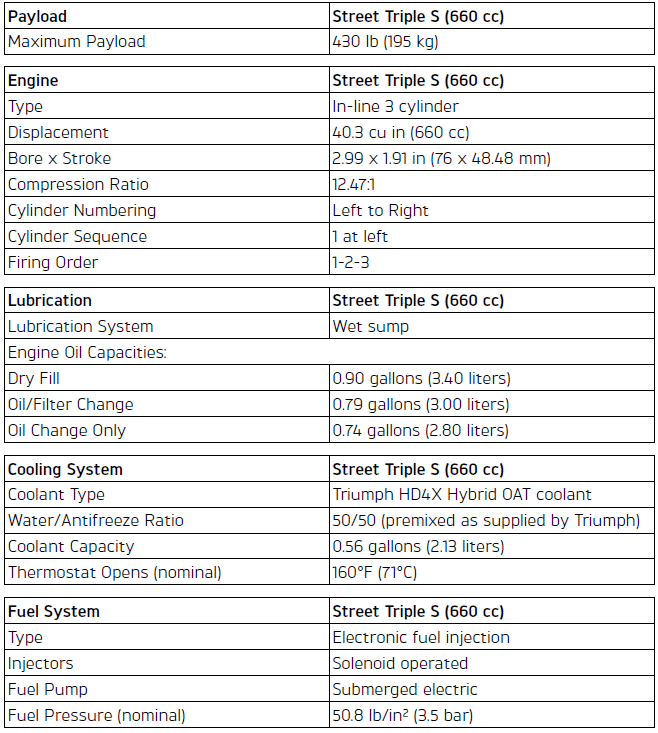
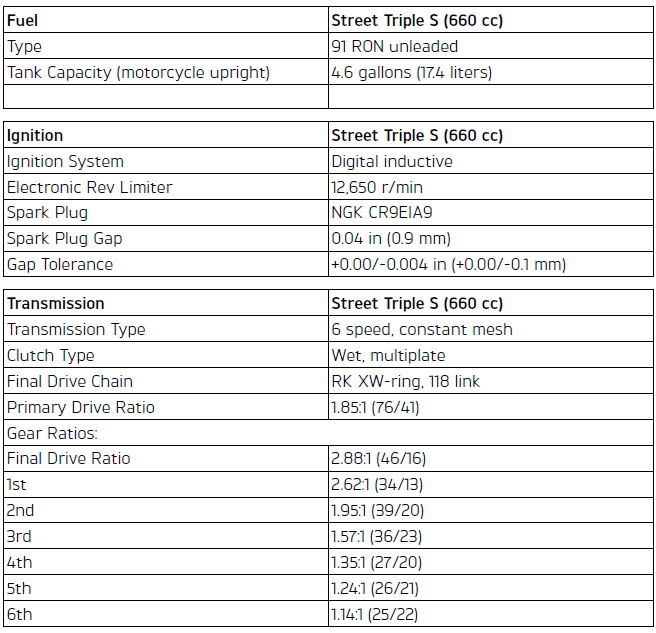
Warning: Use the recommended tires ONLY in the combinations given.
Do not mix tires from different manufacturers or mix different specification tires from the same manufacturers as this may result in loss of motorcycle control and an accident.
Approved Tires
A list of approved tires specific to these models is available from your authorized Triumph dealer, or on the Internet at www.triumph.co.uk.
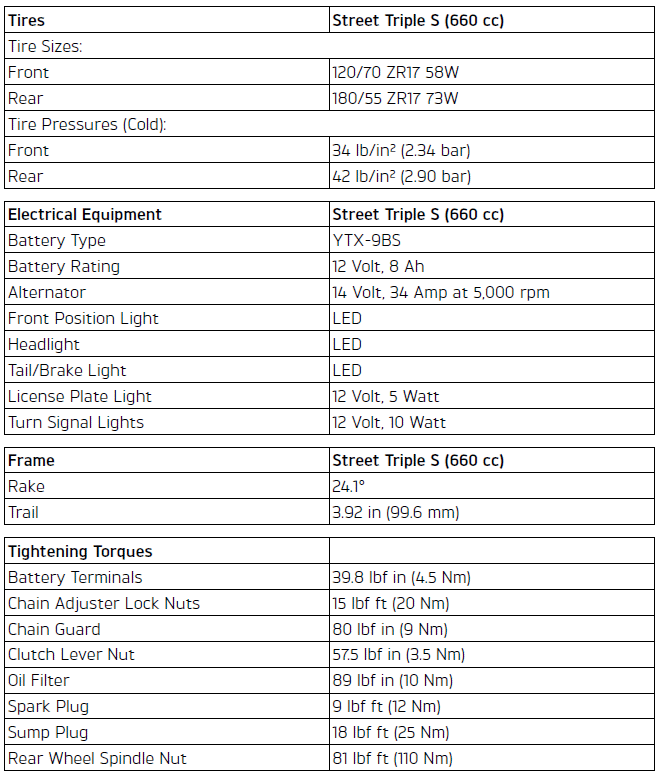

Street Triple R and Street Triple R - LRH
Dimensions, Weights and Performance
A list of model specific dimensions, weights and performance figures is available from your authorized Triumph dealer, or on the Internet at www.triumph.co.uk.

Warning: Use the recommended tires ONLY in the combinations given.
Do not mix tires from different manufacturers or mix different specification tires from the same manufacturers as this may result in loss of motorcycle control and an accident.
Approved Tires
A list of approved tires specific to these models is available from your authorized Triumph dealer, or on the Internet at www.triumph.co.uk.
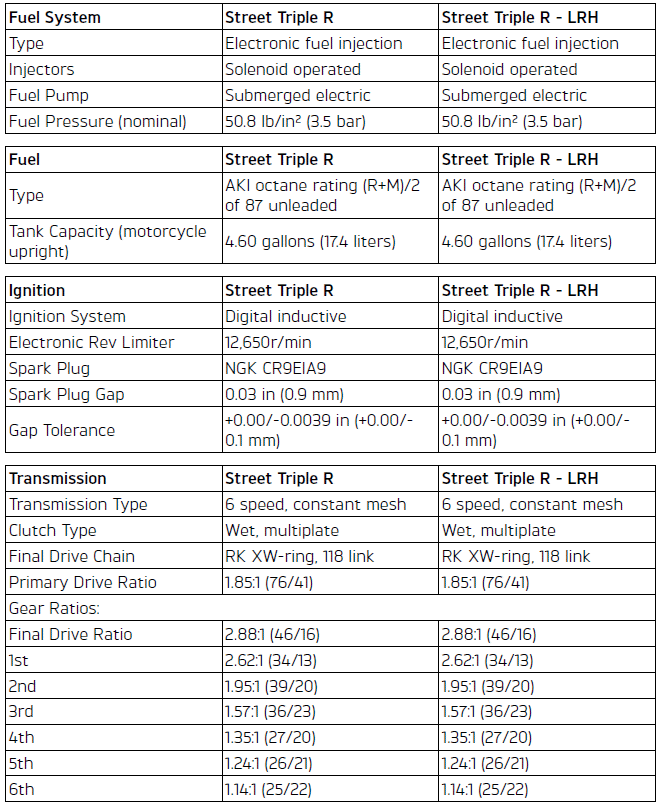
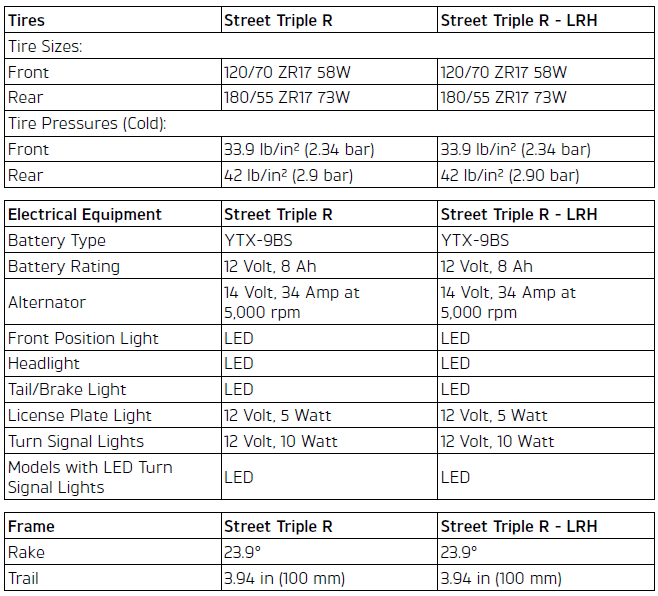
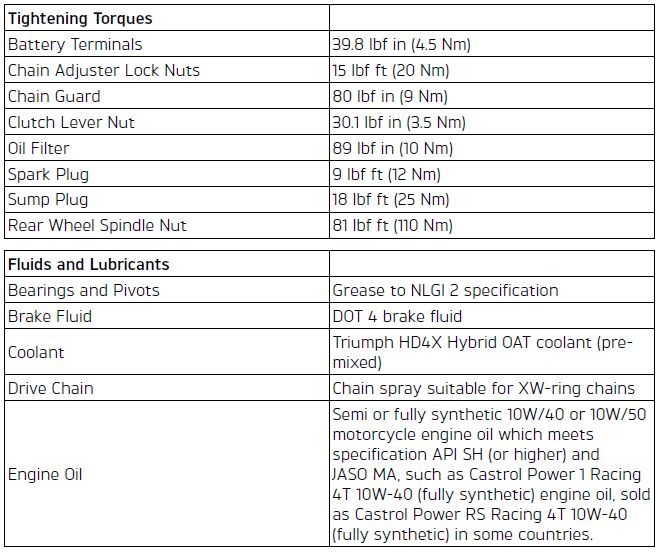
See also:
 Triumph Street Triple S - Owner's Manual > Battery
Triumph Street Triple S - Owner's Manual > Battery
Warning: The battery contains sulfuric acid (battery acid). Contact with skin or eyes may cause severe burns. Wear protective clothing and a face shield. If battery acid gets on your skin, flush with water immediately.

 Benelli Imperiale 400
Benelli Imperiale 400 BMW F900XR
BMW F900XR Honda CB500X
Honda CB500X KTM 390 Adventure
KTM 390 Adventure Triumph Street Triple S
Triumph Street Triple S Yamaha MT-03
Yamaha MT-03 Kawasaki Z400
Kawasaki Z400 Triumph Street Triple S
Triumph Street Triple S Yamaha MT-03
Yamaha MT-03